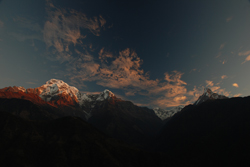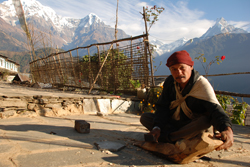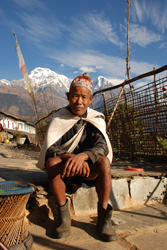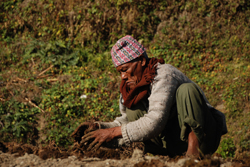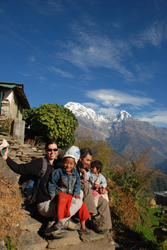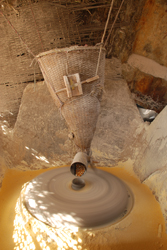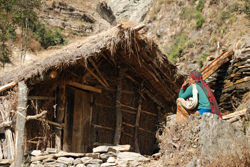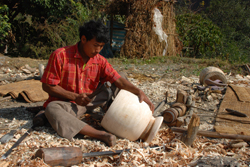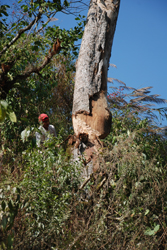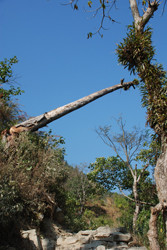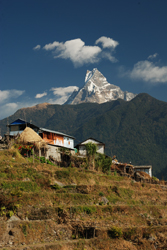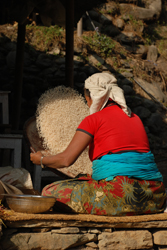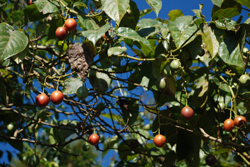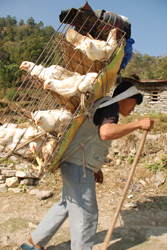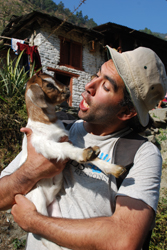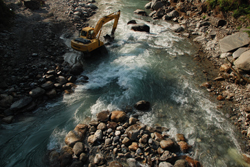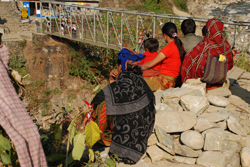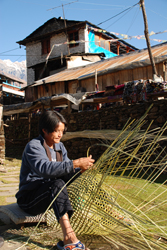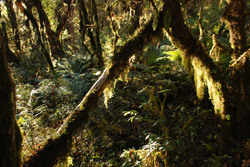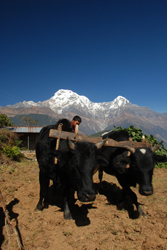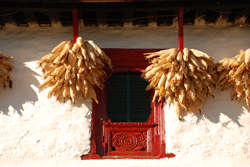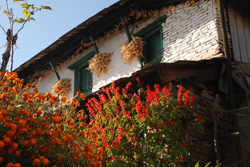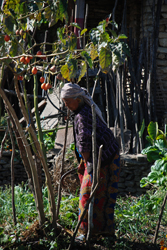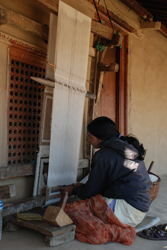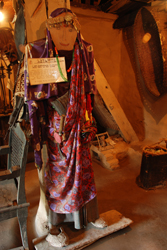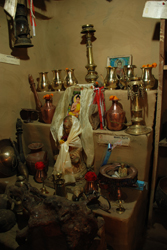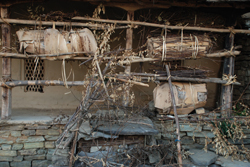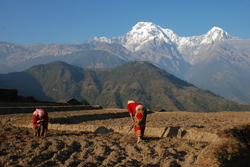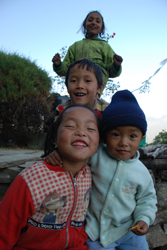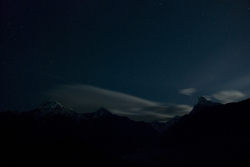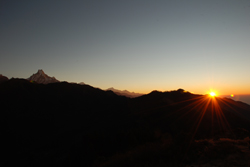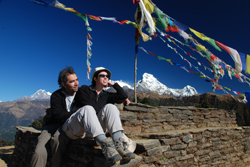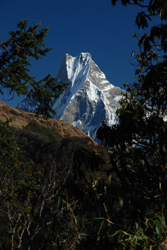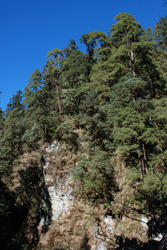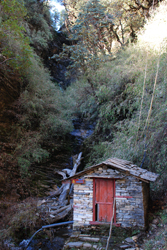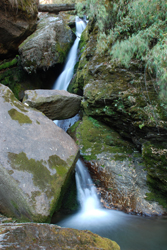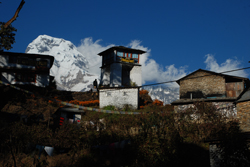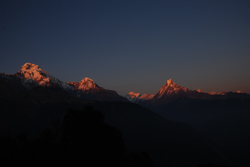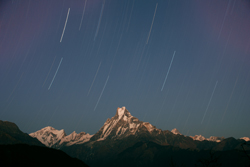Ghorepani Trek Day 5: Back To Pokhara
16 December, 2008, 02:12 am in "Nepal"
Since the town of Ghundruk gets light in the morning and not the afternoon, we talked Dipak into taking a walk with us around Ghundruk before we hiked back to Nayapul. The morning sun lit up the buildings beautifully. The people of the town were enjoying it as well, sitting in front of their houses on flagstone patios and doing morning chores. Rowshan saw a man carving a groove in a new wooden plow. We all joined him. Dipak found out that they have to make a new plow every 15-20 days because they break often from striking stones. The plow takes 2 days to make: 1 to go into the jungle and find the tree for it and then next to carve it.
I should mention how great our guide, Dipak was. He let us set the pace and once he knew Rowshan was interested in photographing butterflies, he searched for them as well and pointed them out. We could tell he was interested in the culture of people in the villages and would talk to them about what they were doing, if not for his own information, then so he could explain in more detail to customers. Often it seems guides are content to just point out the path and say a few set things about the surroundings. If you are in Pokhara and need a guide, contact Dipak at Pristine Mountain Tours on Lakeside.
A little farther on we met some children-- one wearing a plastic bag for a hat. They posed for photos and followed us as we walked down the path. The boy with the bag on his head held his arms out to me. I picked him up and swung him around a bit-- I guess that's what you're supposed to do with little kids right? His name was Aziz and his sister was Barsa. They sat with Rowshan and I-- Aziz on my lap, Barsa on Rowshan's. She tentatively touched his stubble and chest hair peeking out from his shirt-- curious because the men here don't have much facial or body hair. Soon their mother called them away. We eventually, and slightly unwillingly left Ghundruk which seemed like such an idyllic place with its flowers, colored wooden windows, and amazing backdrop of the Himalayas.
A little farther on we met some children-- one wearing a plastic bag for a hat. They posed for photos and followed us as we walked down the path. The boy with the bag on his head held his arms out to me. I picked him up and swung him around a bit-- I guess that's what you're supposed to do with little kids right? His name was Aziz and his sister was Barsa. They sat with Rowshan and I-- Aziz on my lap, Barsa on Rowshan's. She tentatively touched his stubble and chest hair peeking out from his shirt-- curious because the men here don't have much facial or body hair. Soon their mother called them away. We eventually, and slightly unwillingly left Ghundruk which seemed like such an idyllic place with its flowers, colored wooden windows, and amazing backdrop of the Himalayas.
Out of town we stopped at a little building located near a tall waterfall. The mill hut was made of branches bound together with bamboo straps. The walls were of woven grass and branches. Inside a large millstone was turning powered by water from the waterfall. Corn was in the process of being ground but a layer of white powder suggested rice was also ground there. Above the cliffs from which the waterfall plummeted, eagles were circling.
At a village we saw a young man carving water jugs from large chunks of wood. He was using an ax but there were other rough metal tools which he used to somehow make a smooth, finely made jug. A drill type thing for hollowing the jug was operated by leather straps.
The path we walked was mostly stone steps leading down the mountainside. We seemed to be getting into warmer drier climate. The road reached the river level, then rose a little around an area where the road had washed out. A mule train went by. Then as we continued, we heard the sound of an ax. Dipak called out and the woodsman stopped. We saw he was chopping down a dead tree near the road. We rushed past then watched as within a few more chops, the tree fell down across the path.
The path led by villages where people were working, and rice paddies and fields where water buffalo grazed. Butterflies flitted from stones to flowers. One thing kind of interesting about Nepal is some of the giant plant life. Rhododendrons that appear as chest high bushes in the US are 20ft tall trees here. Poinsettias-- seen in little flower pots in the US grow on 10ft tall bushes. The tomatoes we are used to seeing also on small fragile bushes grow on sturdy trees here.
We also saw lots of porters. Even though it looks like a road has been put in, there is still no way for cars to get across the river to the wide path. Dipak said it was put in by a hydroelectric company which wants to start work there. In the meantime, everything that goes to the villages is carried by either mule or porter. We saw 2 porters carrying cages of sickly looking chickens, probably destined for the hotels to serve to tourists. The local chickens that live free ranged scratching by the paths are some of the fattest and healthiest looking chickens I've seen. Beautiful roosters with glistening feathers crow proudly in the sun.
We suddenly were back at Birathanti and the trek was over. We crossed the metal suspension bridge where many people were assembled watching a bulldozer scoop rocks from the river and pile them on land. (All the suspension bridges we saw in the area had signs saying they were built by the Gurkha regiments.)
Back in Pokhara, we went to the Asian Tea House for dinner. There we met Craig and Jennifer, 2 Americans from Miss. who are also doing a RTW trip though are going the opposite direction from us. The delicious dinner and great conversation made us forget how tired we were.
Ghorepani Trek Day 4: Ghandruk a traditional Gurung Village
15 December, 2008, 02:12 am in "Nepal"
It was a short easy walk today of about 3 hours downhill. We left Tadapani where people were busy with their daily chores. The path led through more moss covered rain/cloud forest, redolent with ferns and ribboned through with a waterfall speckled river. Here and there were tiny purple or white flowers. A couple times we came upon clearings that opened out to views of the mountains looming across the valley. I love walking through cloud/rain forests. These forests are quieter than the hot jungles. They filter the sun's light like stained glass windows. They request a certain reverence. The waterfalls even seem quiet and secretive, hiding behind outcroppings of rocks. It is so amazing here. I keep wondering how come I hadn't known how beautiful Nepal is.
Ghandruk is a real village as opposed to a conglomeration of hotels. It has its share of hotels but most buildings seem to be real homes. It is a Gurung village which maintains its traditional look in spite of the masses of trekkers passing through.
As we arrived in the village we passed some men plowing a small field with a stunning view of the mountain. After we managed to drag ourselves away from our sun-drenched seat outside the hotel and the view of the mountains, we walked back through the town looking for the museum.
The town is on a mountainside and the stone houses are connected by a web of flagstone paths and stairs. The houses are care-takingly white washed and have ornate carved wood windows painted to match the roof struts. Gardens are overflowing with yellow, orange and red marigolds and other flowers, adding a touch of pink and purple. Pale yellow ears of corn hang drying under the eves. The town is quiet except for the occasional crowing of a rooster or rush of water in a stream through lush terraces filled with emerald bushes with corpulent leaves and lush grass.
Women sit in the sun talking or working, wearing rich colored clothing. One woman sat at a loom making traditional Gurung seat rugs from natural colored wools of gray and white. Along some of the paths, garlands of dried flowers were draped in modest festivity.
The museum was a room in the downstairs of a traditional house. The room was small but filled with artifacts of Gurung culture, lovingly curated and each containing a description in English of the item's use.
In the entrance of the museum were models of a man and woman in traditional clothing welcoming visitors to their house. Labels contained either a face of the man, Ram Bahadun Gurung, or the woman, Harimaya Gurung, or both signifying who utilized the objects. The labels were written as if either Ram or Harimaya were talking to the reader about the item. It was a creative way of presenting a lot of items and made reading about all the different artifacts very enjoyable.
In the entrance of the museum were models of a man and woman in traditional clothing welcoming visitors to their house. Labels contained either a face of the man, Ram Bahadun Gurung, or the woman, Harimaya Gurung, or both signifying who utilized the objects. The labels were written as if either Ram or Harimaya were talking to the reader about the item. It was a creative way of presenting a lot of items and made reading about all the different artifacts very enjoyable.
There were a couple small models: a wooden ferris wheel powered by 2 people, and a water mill. There were also lots of tools and a large number of different bamboo baskets and wood containers, each having a specific use. I pointed out some clay I saw in a wooden box, to Rowshan, then walked over to another section of the room and started reading about Harimaya's morning chores. A moment later I heard Rowshan exclaim, “This isn't clay, it's SHIT!”. He had pulled out a piece of the substance in the box and had been examining it when he recognized the smell. At that moment I read that Harimaya, every morning, spreads a mixture of clay and manure in front of the door and fireplace. This was called, “pasting”. There was also clay in the box but Rowshan had grabbed a piece of the other ingredient.
Among the other artifacts were a water pipe, weaving loom, butter churn, and a smaller churn for making butter tea. There were drums used by a lama for healing, an alter, and instructions for making Raxi, the local alcoholic drink made from fermented millet. As we were looking at the various items, a young girl came in and brushed the strings of a sarangi, tapped a drum and played with the butter churn, and the bracelets worn by the woman model. I assume she was the daughter of the curator. When we left, I opened the guest book. She made sure it was on the right page. I paid her the entrance fee and she stood looking at the money on the roof of the house, lower on the hill, and called something to someone within view.
The outside of the house also had plenty of interesting items including a hole leading underneath where chickens would live, and a log beehive. Earlier, Rowshan had noticed many bees flying around the marigolds and suggested we look for wild hives. I said people probably had boxes but I hadn't seen any. The hives were pieces of logs with holes in the side. After knowing what to look for we saw many set on the roof of the front porches of the houses or on the sides of the houses disguised with branches or corn husks. The museum info is: The Old Gurung Museum, Ghandruk 5, Kaski, Nepal, Curator: Uktaman Gurung, cost 30rs admission, hours 7am-7pm, open since 1992.
A little farther up the street we found another Gurung Museum. We didn't go in assuming it was the same, and probably an inferior knock off of the first which was so well prepared.
It must be kind of frustrating to have a good idea in Nepal because it will be unscrupulously copied. The 2nd museum was down the same street and even had its signs next to the signs of the first.
We continued our walk admiring the houses. Children raced past begging for sweets as they went. Rowshan took some photos of women digging up clay (I presume for pasting). In another field women were digging up potatoes.
It must be kind of frustrating to have a good idea in Nepal because it will be unscrupulously copied. The 2nd museum was down the same street and even had its signs next to the signs of the first.
We continued our walk admiring the houses. Children raced past begging for sweets as they went. Rowshan took some photos of women digging up clay (I presume for pasting). In another field women were digging up potatoes.
We eventually wandered back up the path cutting through the museum and entertaining a group of kids with Rowshan's camera. The path wound around and up past hotels and we came to the hotel. There had been a lot of fires today. People collect leaves from the forest and burn them in the fields for fertilizer.
Ghorepani Trek Day 3: Ghorepani to Tadapani: Mystical Mountain Morning
14 December, 2008, 02:06 am in "Nepal"
It was a restless night for me due to the cold, the discomfort of a stuffed up nose, and too much clothing. So it wasn't too difficult getting up at 5:15. After checking the view from the window and seeing it was clear, we got up and got ready, not difficult since we had slept in almost all of our clothing. The sky was a deep blue and the mountains shone in the night from the light of the full moon. In the East was a faint tint of rose. The stars shimmered above the mountains. We started up the hill, climbing steps lit by the moon. As if all this wasn't magical enough, Rowshan glanced back and saw 2 meteorites-- one especially bright. A little later I saw a couple and Rowshan saw one more. It was a mystical walk and felt a bit druidic.
The light of the rising sun washed over the Dhaulagiri range. Mammoth Dhaulagiri I--the 7th largest peak in the world at 8167 meters, was not only high but broad. Annapurna South with its attached Hiunchuli and Nilgiri (the peak between the Annapurnas and Dhaulagiris) all received their pink glow of light.
The light of the rising sun washed over the Dhaulagiri range. Mammoth Dhaulagiri I--the 7th largest peak in the world at 8167 meters, was not only high but broad. Annapurna South with its attached Hiunchuli and Nilgiri (the peak between the Annapurnas and Dhaulagiris) all received their pink glow of light.
We went back down to Ghorepani, had breakfast and left, climbing up another hill above the town. The day was still crystal clear as we reached the summit with its stone porter rest stations adorned with prayer flags. Here we rested soaking up the last view we'd have of both the Dhaulagiri and Annapurna ranges before heading down the other side of the hill.
Down the hill we walked through a more subtropical environment. We came to a deep gorge whose sheer rock walls stretched up to become a mountain above us. The gray stone was coated with moss. We came upon a tiny hydroelectric power station which provided electricity for the village. I thought it strange that such a tiny, unobtrusive building could provide power from the little stream it was next to. Dipak said many of the villages have these tiny power stations.
We crossed a bridge which had a sign saying the stream was the “Saranga River”. I guess during the monsoon it becomes a raging river. The river's course had been changed into an obstacle course of cascades, pools and waterfalls by a rock slide which had sent huge platforms of rock, some probably more than 20 feet across, into the river bed. As we climbed out of the gorge, we saw a stocky deer race down the steep slope to the river.
We found ourselves on the side of a mountain with a view of Ulleri, the first village we'd stayed in. Annapurna South made its appearance behind the curve of the hill. We made a steep descent and a steep ascent and were soon near Tadopani. Rowshan thought he saw a monkey but it turned out to be a different animal, perhaps a yellow throated marten, something that looked like a cross between a cat, a monkey, and a skunk. It was trying to pilfer a crow's nest which is what had caused the commotion which attracted R's attention. At one point it stood on a branch looking at us with its cat face and pretty black side stripes.
Tadopani is set on a hillside across and under Annapurna South and Machhapuchre. We saw another pretty pink sunset and talked to fellow travelers Haley, from Australia (ending a 2 year trip soon) and Andrew, also from Australia who aside from hiking the Annapurna Base Camp hike, was in Nepal to compete in the Elephant Polo world championships in order to raise money to help find a cure from MS. Andrew was not a professional elephant polo player or even a regular polo player. His first time playing elephant polo was when he came to Nepal for the competition. For more info about their team see the Pukkachukkas web site. This made for some interesting dinner and post dinner conversation. Andrew left the next morning accompanied by his guide and 2 stray dogs who had followed them down the mountain side from Deurali. Each dog had taken a position in front of Andrew and his guides separate doors, sleeping there in their voluntary posts of trusty guardian.
Tadopani is set on a hillside across and under Annapurna South and Machhapuchre. We saw another pretty pink sunset and talked to fellow travelers Haley, from Australia (ending a 2 year trip soon) and Andrew, also from Australia who aside from hiking the Annapurna Base Camp hike, was in Nepal to compete in the Elephant Polo world championships in order to raise money to help find a cure from MS. Andrew was not a professional elephant polo player or even a regular polo player. His first time playing elephant polo was when he came to Nepal for the competition. For more info about their team see the Pukkachukkas web site. This made for some interesting dinner and post dinner conversation. Andrew left the next morning accompanied by his guide and 2 stray dogs who had followed them down the mountain side from Deurali. Each dog had taken a position in front of Andrew and his guides separate doors, sleeping there in their voluntary posts of trusty guardian.
Powered by My Blog 1.69. Copyright 2003-2006 FuzzyMonkey.net.
Created by the scripting wizards at FuzzyMonkey.net..
(Code modified by Rowshan Dowlatabadi)
Created by the scripting wizards at FuzzyMonkey.net..
(Code modified by Rowshan Dowlatabadi)


